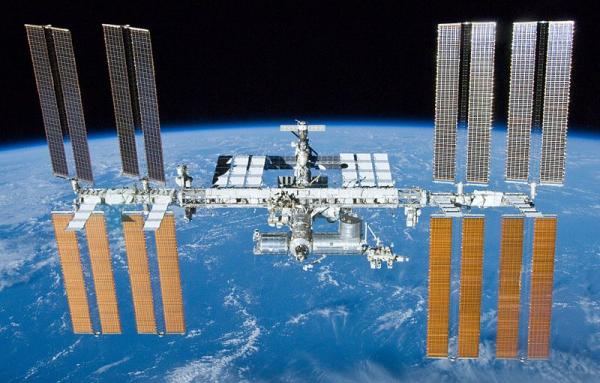The International Space Station
The International Space Station (ISS) is a spacecraft large enough for several astronauts to live on at once. It orbits the Earth 400 km above our planet's surface, travelling at 27,600 km/hour. This means it completes 1 orbit of the Earth in 90 minutes! You can sometimes see the ISS at night - you don't need a telescope. It looks like a small, bright dot moving quickly across the sky. You can find out where and when the ISS will appear in the sky with Spot the Station.

Credit: NASA/Crew of STS-132
Space agencies around the world work together to build and use the ISS. NASA launched the first piece of the ISS in 1998 from the Kennedy Space Center in Florida, USA. Between 1998 and 2000, more pieces were added until the ISS was safe for the crew to live on. The first crew arrived at the ISS on 2nd November 2000 but the station was not complete until 2011.
The ISS has two sections: the Russian Orbital Segment and the United States Orbital Segment. Inside the ISS, there are science labs, control stations, and living quarters, connected to each other by 'nodes'. Energy from the Sun provides electricity to the ISS. Huge solar panels on each side of the space station collect light from the Sun.
A crew of 6 or 7 men and women from various nations around the world live on board the ISS for 6 to 12 months at a time. The crew live in microgravity which means everything floats! This happens because the station is in free fall around the Earth. This makes the ISS a special place to study the effects of weightlessness on people, plants, and animals. The crew spend their time doing science experiments as well as studying the Earth and space weather. They also study how materials and technology work in space as well as space medicine! The crew exercise for 2 hours each day to keep their muscles and bones healthy.
The crew enter and exit the ISS through airlocks. This lets them to go outside to add improvements to the ISS and fix any problems. When they are outside the station we call this a spacewalk, through the official name is an extravehicular activity (EVA). Large robotic arms on the spacecraft help them to move scientific equipment around the outside of the space station. Docking ports allow other spacecraft to connect to the ISS to bring other astronauts or supplies.
The US Space Agency have announced that the ISS will be used until 2030. In 2031, it will crash down into the Pacific Ocean. This part of the ocean, known as the 'spacecraft cemetery' is the point on Earth furthest from any land. Other space junk has been crashed here, including the Mir space station.

